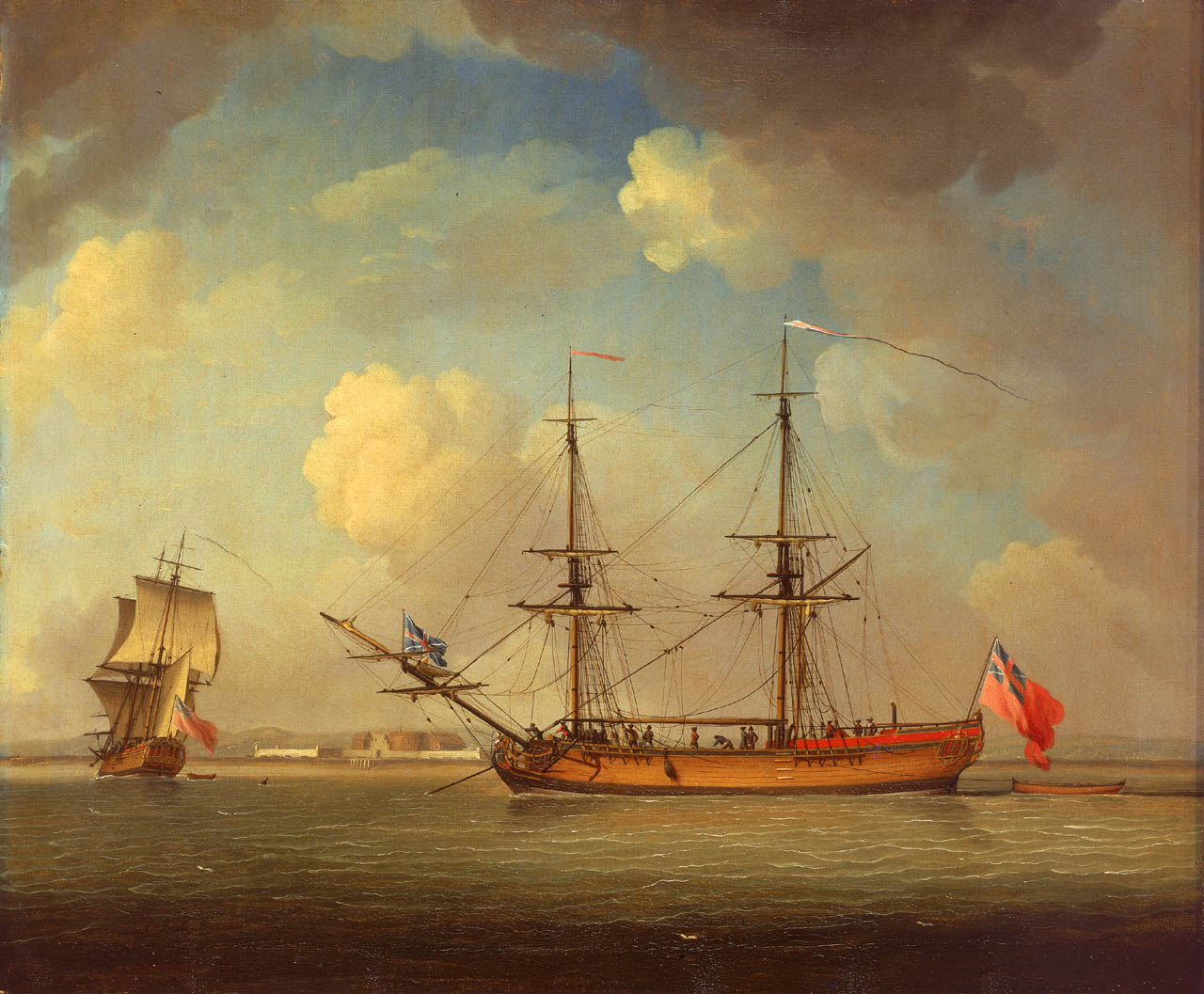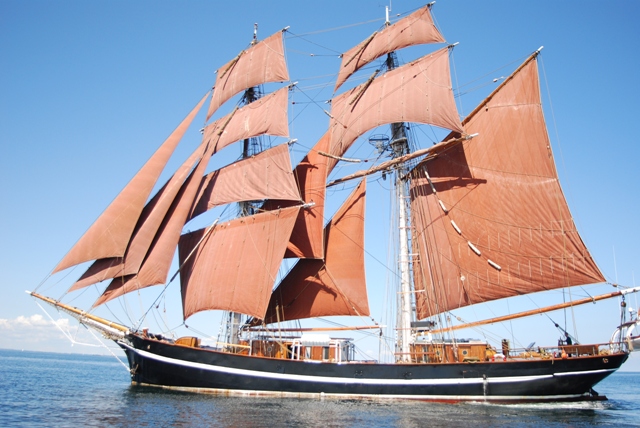|
Brigantine
A brigantine is a two-masted sailing vessel with a fully square-rigged foremast and at least two sails on the main mast: a square topsail and a gaff sail mainsail (behind the mast). The main mast is the second and taller of the two masts. Older usages are looser; in addition to the rigorous definition above (attested from 1695), the ''Oxford English Dictionary'' has about 1525 definitions of "a small vessel equipped both for sailing and rowing, swifter and more easily manœuvred than larger ships" and "(loosely) various kinds of foreign sailing and rowing vessels, as the galleon, galliot, etc." Modern American definitions include vessels without the square sails on the main mast. Mediterranean brigantines In the Mediterranean Basin during the 13th century, a brigantine referred to a sail- and oar-driven war vessel. It was lateen rigged on two masts and had between eight and twelve oars on each side. Its speed, maneuverability, and ease of handling made it a favourite of Med ... [...More Info...] [...Related Items...] OR: [Wikipedia] [Google] [Baidu] |
Brig
A brig is a type of sailing vessel defined by its rig: two masts which are both square-rigged. Brigs originated in the second half of the 18th century and were a common type of smaller merchant vessel or warship from then until the latter part of the 19th century. In commercial use, they were gradually replaced by fore-and-aft rigged vessels such as schooners, as owners sought to reduce crew costs by having rigs that could be handled by fewer men. In Royal Navy use, brigs were retained for training use when the battle fleets consisted almost entirely of iron-hulled steamships. Brigs were prominent in the coasting coal trade of British waters. 4,395 voyages to London with coal were recorded in 1795. With an average of eight or nine trips per year for one vessel, that is a fleet of over 500 colliers trading to London alone. Other ports and coastal communities were also be served by colliers trading to Britain's coal ports. In the first half of the 19th century, the vast majority ... [...More Info...] [...Related Items...] OR: [Wikipedia] [Google] [Baidu] |
Brig (ship)
A brig is a type of sailing vessel defined by its rig: two masts which are both square-rigged. Brigs originated in the second half of the 18th century and were a common type of smaller merchant vessel or warship from then until the latter part of the 19th century. In commercial use, they were gradually replaced by fore-and-aft rigged vessels such as schooners, as owners sought to reduce crew costs by having rigs that could be handled by fewer men. In Royal Navy use, brigs were retained for training use when the battle fleets consisted almost entirely of iron-hulled steamships. Brigs were prominent in the coasting coal trade of British waters. 4,395 voyages to London with coal were recorded in 1795. With an average of eight or nine trips per year for one vessel, that is a fleet of over 500 colliers trading to London alone. Other ports and coastal communities were also be served by colliers trading to Britain's coal ports. In the first half of the 19th century, the vast majority ... [...More Info...] [...Related Items...] OR: [Wikipedia] [Google] [Baidu] |
Snow (ship)
In sailing, a snow, snaw or snauw is a square-rigged vessel with two masts, complemented by a snow- or trysail-mast stepped immediately abaft (behind) the main mast.Hans Haalmeijer (2009). Pinassen, fluiten en galjassen, the Netherlands: Uitgeverij De Alk B.V. History The word 'snow' comes from 'snauw', which is an old Dutch word for beak, a reference to the characteristic sharp bow of the vessel. The snow evolved from the (three-masted) ship: the mizzen mast of a ship was gradually moved closer towards the mainmast, until the mizzen mast was no longer a separate mast, but was instead made fast at the main mast top. As such, in the 17th century the snow used to be sometimes classified as a three-masted vessel. The snow dates back to the late 17th century and originally had a loose-footed gaff sail; the boom was introduced somewhere in the 18th century. It was a popular type of vessel in the Baltic Sea and was employed by a large number of nations during its time. The snow w ... [...More Info...] [...Related Items...] OR: [Wikipedia] [Google] [Baidu] |
Eye Of The Wind
''Eye of the Wind'' is a brigantine built in 1911 at the C. H. Lühring shipyard in Brake, Germany, originally as a topsail schooner named ''Friedrich''. History ''Friedrich'' was initially used as a schooner for the South American hide trade. In 1923 she was registered in Sweden, under the name ''Merry'', and was used for transport in the Baltic and North seas and for fishing herring off the coast of Iceland during summer. In 1969, then stripped of her masts and sailing as a motor vessel, she was severely damaged in a fire that almost destroyed her. In 1973 a group of sailing enthusiasts, including Anthony "Tiger" Timbs, who later became her Master, began rebuilding her at Faversham, England. In this restoration she was re-rigged as a brigantine by Master Rigger Wally Buchanan. After the restoration was completed she was given the name ''Eye of the Wind'', inspired by Sir Peter Scott's 1961 book. In October 1976 she set sail for Australia, the first voyage since the restorat ... [...More Info...] [...Related Items...] OR: [Wikipedia] [Google] [Baidu] |
Sailing Ships
A sailing ship is a sea-going vessel that uses sails mounted on masts to harness the power of wind and propel the vessel. There is a variety of sail plans that propel sailing ships, employing square-rigged or fore-and-aft sails. Some ships carry square sails on each mast—the brig and full-rigged ship, said to be "ship-rigged" when there are three or more masts. Others carry only fore-and-aft sails on each mast, for instance some schooners. Still others employ a combination of square and fore-and-aft sails, including the barque, barquentine, and brigantine. Early sailing ships were used for river and coastal waters in Ancient Egypt and the Mediterranean. The Austronesian peoples developed maritime technologies that included the fore-and-aft crab-claw sail and with catamaran and outrigger hull configurations, which enabled the Austronesian expansion into the islands of the Indo-Pacific. This expansion originated in Taiwan BC and propagated through Island Southeast Asi ... [...More Info...] [...Related Items...] OR: [Wikipedia] [Google] [Baidu] |
Zebu (ship)
Zebu, formerly Ziba, was a historic tall ship. Built in Sweden in 1938, she was used as a trading vessel until the late 1960s, before circumnavigating the globe in the 1980s. She has been based in Liverpool since the 1980s. She sank in 2015, and was subsequently restored. She partially sank again in 2021 after running aground on Holyhead breakwater after slipping her anchor, and had masts and sails removed to reduce weight so the hull could be moved. On 21 May 2021 after suffering further damage due to a storm, she was declared a wreck. History Baltic trading vessel The wood-hulled sailing ship was laid down and built in 1938 at A.B. Holms, Råå, Sweden. Originally named Ziba, she was built as a Galleass, and was used as a Baltic trading vessel, carrying cargo such as wood, paper, and iron ore. She originally had a Ketch rig. She is in overall length, of which is the hull, with a beam of and a draught of . During the Second World War, she was possibly used to smuggle ... [...More Info...] [...Related Items...] OR: [Wikipedia] [Google] [Baidu] |
Square-rig
Square rig is a generic type of sail and rigging arrangement in which the primary driving sails are carried on horizontal spars which are perpendicular, or square, to the keel of the vessel and to the masts. These spars are called ''yards'' and their tips, outside the lifts, are called the ''yardarms.'' A ship mainly rigged so is called a square-rigger. The square rig is aerodynamically the most efficient running rig (i.e., sailing downwind), and stayed popular on ocean-going sailing ships until the end of the Age of Sail. The last commercial sailing ships, windjammers, were usually square-rigged four-masted barques. History The oldest archaeological evidence of use of a square-rig on a vessel is an image on a clay disk from Mesopotamia from 5000 BC. Single sail square rigs were used by the ancient Egyptians, the Phoenicians, the Greeks, the Romans, and the Celts. Later the Scandinavians, the Germanic peoples, and the Slavs adopted the single square-rigged sail, with it b ... [...More Info...] [...Related Items...] OR: [Wikipedia] [Google] [Baidu] |
Ship Types
A ship is a large watercraft that travels the world's oceans and other sufficiently deep waterways, carrying cargo or passengers, or in support of specialized missions, such as defense, research, and fishing. Ships are generally distinguished from boats, based on size, shape, load capacity, and purpose. Ships have supported exploration, trade, warfare, migration, colonization, and science. After the 15th century, new crops that had come from and to the Americas via the European seafarers significantly contributed to world population growth. Ship transport is responsible for the largest portion of world commerce. The word ''ship'' has meant, depending on the era and the context, either just a large vessel or specifically a ship-rigged sailing ship with three or more masts, each of which is square-rigged. As of 2016, there were more than 49,000 merchant ships, totaling almost 1.8 billion dead weight tons. Of these 28% were oil tankers, 43% were bulk carriers, and 13% were ... [...More Info...] [...Related Items...] OR: [Wikipedia] [Google] [Baidu] |
Sailing Ship Types
Sailing employs the wind—acting on sails, wingsails or kites—to propel a craft on the surface of the ''water'' (sailing ship, sailboat, raft, windsurfer, or kitesurfer), on ''ice'' (iceboat) or on ''land'' (land yacht) over a chosen course, which is often part of a larger plan of navigation. From prehistory until the second half of the 19th century, sailing craft were the primary means of maritime trade and transportation; exploration across the seas and oceans was reliant on sail for anything other than the shortest distances. Naval power in this period used sail to varying degrees depending on the current technology, culminating in the gun-armed sailing warships of the Age of Sail. Sail was slowly replaced by steam as the method of propulsion for ships over the latter part of the 19th century – seeing a gradual improvement in the technology of steam through a number of stepwise developments. Steam allowed scheduled services that ran at higher average speeds than saili ... [...More Info...] [...Related Items...] OR: [Wikipedia] [Google] [Baidu] |






